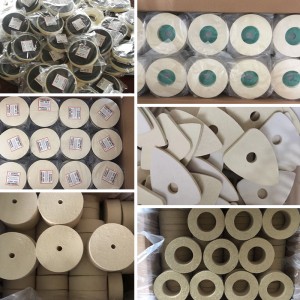3D printed parts often come with rough surfaces, layer lines, and support material remnants that need to be smoothed out for optimal functionality and aesthetics. Traditional post – processing methods, such as sanding or chemical treatments, can be time – consuming, imprecise, or even damaging to the printed material. Wool felt wheels, with their soft yet durable nature, offer a superior alternative.
For thermoplastic 3D printed parts, like those made from ABS or PLA, wool felt wheels can be used to gently polish the surface. The fine wool fibers conform to the contours of the object, effectively reducing layer lines and creating a smooth finish. In the production of custom – designed 3D printed jewelry, artisans are leveraging wool felt wheels to enhance the luster of the pieces. A jewelry designer specializing in 3D printed accessories shared that using wool felt wheels not only improves the visual appeal of the jewelry but also makes the surface more comfortable to wear, as it eliminates any rough edges.
In the automotive and aerospace sectors, where 3D printing is increasingly used to produce prototypes and small – batch components, wool felt wheels play a vital role in ensuring parts meet strict quality standards. For instance, in the creation of 3D printed engine components for concept cars, wool felt wheels are employed to polish the internal and external surfaces, improving the aerodynamics and reducing friction. This meticulous finishing process can significantly enhance the performance and durability of the parts.
Moreover, wool felt wheels can be customized to suit different 3D printing materials and post – processing requirements. Manufacturers are developing wheels with varying densities and hardness levels, allowing users to select the most appropriate one for their specific 3D printed objects. Some are even experimenting with impregnating the wool felt with specialized compounds to further enhance the polishing effect on different materials.
However, the adoption of wool felt wheels in 3D print post – processing also comes with its own set of considerations. The type of 3D printing technology used, such as fused deposition modeling (FDM) or stereolithography (SLA), can influence the effectiveness of the wool felt wheel treatment. Additionally, proper technique and equipment are essential to achieve consistent results. As the 3D printing industry continues to evolve, the synergy between wool felt wheels and 3D print post – processing is expected to drive further innovation, enabling the creation of higher – quality 3D printed products across various industries.
Post time: Jun-05-2025

